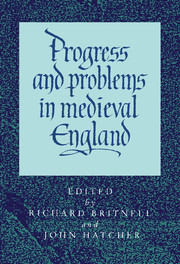Book contents
- Frontmatter
- Contents
- List of figures
- List of maps
- List of tables
- List of contributors
- Edward Miller: an appreciation
- List of abbreviations
- 1 Economic development in the early twelfth century
- 2 Lothian and beyond: the economy of the ‘English empire’ of David I
- 3 Boroughs, markets and trade in northern England, 1000–1216
- 4 Peasant deer poachers in the medieval forest
- 5 The growth of London in the medieval English economy
- 6 The bankruptcy of the Scali of Florence in England, 1326–1328
- 7 The English export trade in cloth in the fourteenth century
- 8 A medieval tax haven: Berwick upon Tweed and the English crown: 1333–1461
- 9 Taxation and communities in late medieval England
- 10 Peasants and the collapse of the manorial economy on some Ramsey Abbey estates
- 11 The famuli in the later Middle Ages
- 12 The great slump of the mid-fifteenth century
- 13 Lorenzo de' Medici's London branch
- 14 The trade of late medieval Chester, 1500–1550
- Bibliography of Edward Miller's published works
3 - Boroughs, markets and trade in northern England, 1000–1216
Published online by Cambridge University Press: 05 June 2012
- Frontmatter
- Contents
- List of figures
- List of maps
- List of tables
- List of contributors
- Edward Miller: an appreciation
- List of abbreviations
- 1 Economic development in the early twelfth century
- 2 Lothian and beyond: the economy of the ‘English empire’ of David I
- 3 Boroughs, markets and trade in northern England, 1000–1216
- 4 Peasant deer poachers in the medieval forest
- 5 The growth of London in the medieval English economy
- 6 The bankruptcy of the Scali of Florence in England, 1326–1328
- 7 The English export trade in cloth in the fourteenth century
- 8 A medieval tax haven: Berwick upon Tweed and the English crown: 1333–1461
- 9 Taxation and communities in late medieval England
- 10 Peasants and the collapse of the manorial economy on some Ramsey Abbey estates
- 11 The famuli in the later Middle Ages
- 12 The great slump of the mid-fifteenth century
- 13 Lorenzo de' Medici's London branch
- 14 The trade of late medieval Chester, 1500–1550
- Bibliography of Edward Miller's published works
Summary
For local trade in the north of England, as it is now, the coming of the Normans was a great divide – so great that there is a danger of exaggerating its significance. This territory, whose ultimate control was disputed between the kings of Scotland and England for much of the period under present consideration, is defined here as England to the north of York. It comprises the North Riding of Yorkshire, the Furness district of Lancashire and the four counties of Cumberland, Westmorland, Northumberland and Durham, as they were before county boundaries were altered in 1974. Before the late eleventh century there is little evidence either of urban development or of any formal trading institutions in all this region. The only borough was York on its southern margin. Domesday Book describes it twelve times as a city (civitas) and four times as a town (urbs), but its population included burgesses (burgenses). York had over 636 inhabited messuages in 1086; though the Domesday survey does not permit an exact count, the city's reduced population was perhaps below 5,000. The mint there was the most northerly in England throughout the late Saxon period. Durham was an important monastic centre, but the urban settlement there was as yet a small one. Neither Carlisle nor Newcastle existed. Outside York and perhaps Durham no markets and fairs are recorded.
- Type
- Chapter
- Information
- Progress and Problems in Medieval EnglandEssays in Honour of Edward Miller, pp. 46 - 67Publisher: Cambridge University PressPrint publication year: 1996
- 6
- Cited by



